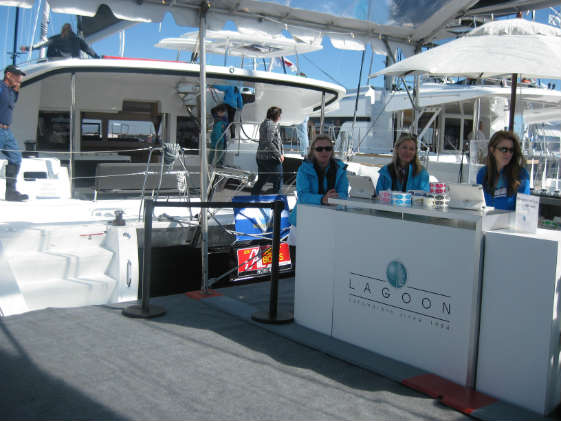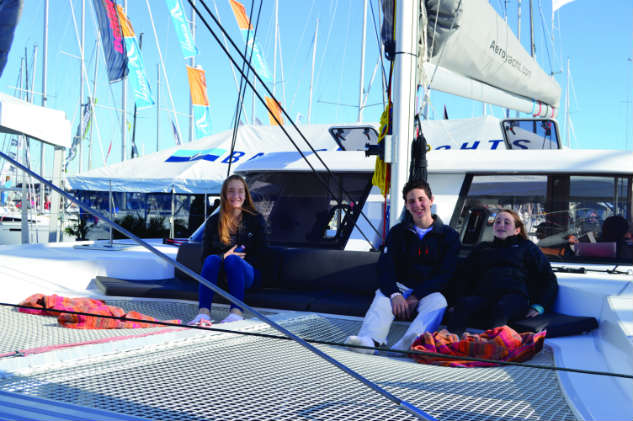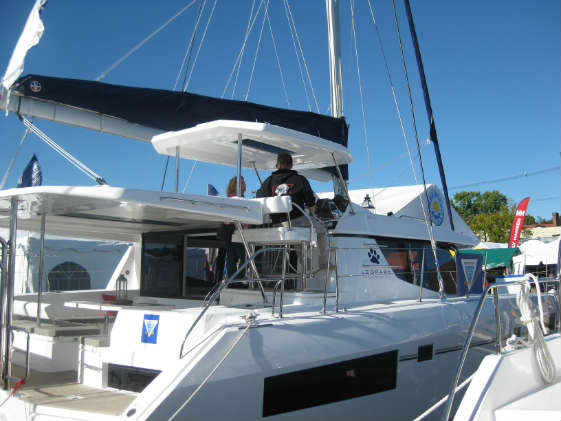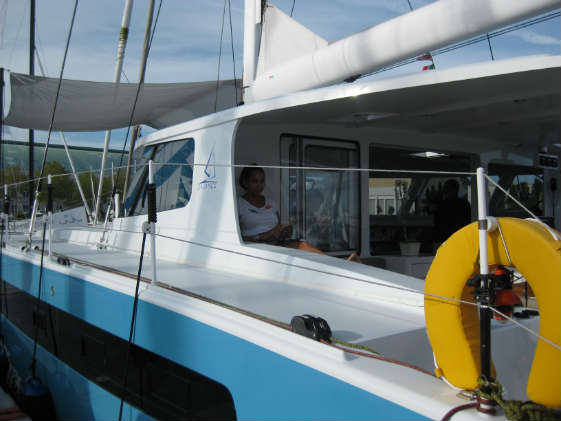Get the Info You Need with These Questions About Multihulls
"Can this baby fly a hull?” This is an example of what not to ask if you go aboard a cruising catamaran at the U.S. Sailboat Show in Annapolis. But don’t let the extra hull intimidate you. Often boat show goers are segregated into monohull and multihull tribes. I know there have been years where I spent all day at the show and never stepped foot onboard a monohull. And I know monohull friends who never climb on board the multihulls. If you’re new to cruising cats and want to check them out at a boat show, here are five questions to ask, followed by some other considerations.

1. Did this boat come over from the manufacturer on its own or was it shipped?
This is a sneaky way to see if it’s a true bluewater boat or an island hopper. Those selling the boat will be hesitant to say “no” when asked if the boat is “offshore” or “bluewater”? But asking how the boats get from wherever they are made (such as South Africa or Europe) to the United States will speak volumes on what the boat can handle.

2. What’s the draft?
This seems like a really basic question, but there can be surprising answers. Cats have a reputation for shallow drafts, so many people don’t even bother checking, assuming it will be two to three feet. However, more and more production cats have drafts up to five feet and more.
3. How big of a dinghy can it hold?
When it comes to dinghies, size matters. Cats are all about balance, and having a huge, heavy dink is going to impact sailing performance and weigh the boat down on the stern. Find out how much weight is realistic for the boat you’re checking out.

4. What is the load carrying capacity of the boat?
There is usually a hard and fast number from the manufacturer on how much extra weight a multihull can or should carry before sailing performance or safety is affected. Find out what that number is and what they already took into consideration when coming up with that number. Do they mean from a totally empty, stripped down boat? Or do they mean with sails and everything already on there? The stuff of life fills a boat up fast, but you can’t be a hoarder on a catamaran.
5. What is the engine access like?
Show boats don’t often have the engines open and on display. Ask the broker if you can see both engines on the catamaran. Some cats have whole engine rooms you can access. Some have the engines under a bunk, which is not exactly a convenient place. Some have them mid-ships; some stick them way aft. Some have excellent access on the port side and mediocre access on the starboard or vice versa. Ask to check it out.
6. So, how much does this boat cost?
And once you get over the sticker shock, find out what that price includes. Cats come at a premium, but you are paying for a whole different cruising experience. Many converts say once you go cat, you never go back to monohull. But the boat show price often only gets you the bare bones boat. Ask about exactly what that price tag includes and excludes.

Here are some other things to look for:
Design
Before you even step onboard a catamaran, step back and have a look. Two things you should take note of are the bridgedeck clearance and windage. There is a careful balance in how these two come together on a cruising cat. A low bridgedeck clearance means the dreaded slap. As you go over chop or waves, water hits the underside of the boat and makes an awful thud, which can get pretty tiring on a long passage and isn’t great for the boat. However, a really high bridgedeck clearance often means the boat has lots of vertical freeboard making windage a problem. The side of the boat being so high and flat can act as a fiberglass sail that you can’t trim. You want to find that balance between adequate clearance underneath and nice lines up top to keep her moving smoothly.
Catamarans have a reputation for being flat and fast, but not all cats check those boxes. Getting from the cockpit to the foredeck can vary wildly from cat to cat. Some have wide, flat decks that are safe and easy to walk stern to bow and back. Other multihulls have narrow passageways alongside or slightly curved decks that make the walk precarious in a rough sea. Walk along and see how it feels getting fore and aft.
Another design consideration is visibility from the helm. Some cats have a nice two-person, raised helm seat allowing the on-watch crew to sit comfortably and see all four corners of the boat. Others have a helm stationed in such a way that you’d need to be about six feet tall to see above the cabin top from a seated position. Some cruising multihulls have two helms, one port and one starboard, both usually set fairly aft. This set-up allows for good visibility for all points of sail, but often leaves the helmsperson exposed to the elements with no bimini or hard top to cover them.
Then there are helm stations that are raised one story up from the cockpit. This works for some people because it allows for a larger cockpit; it creates a nice little nook for the person on watch and usually means you can see your sails clearly. It also means you more than likely cannot see all four corners of your boat. That can make docking tricky. Some people don’t like the motion of the ocean from a raised helm. The height increases the pendulum effect that you feel and can bring on motion sickness for those who are sensitive to it.

Inside
Step inside and do a generic walk around the boat. It’s easy to oooo and ahhh at the fancy interior design mock-up boat show catamarans often display. Look beyond the vases of flowers and the matching pillows and think about the realities of everyday cruising.
Catamarans are spacious, but there is space and there is usable space. Wide open spaces might be nice for boat shows and cocktail parties, but they aren’t very practical for regular sailing and cruising. On the flip side, tons of storage space is fabulous, but not very practical on a cruising cat because loading them up with “stuff” will weigh them down and decrease sailing performance. If the space is there, you will fill it up. Once again, it’s about striking that balance.
Another place to seek balance is in your hatches and windows. Loads of hatches mean fabulous ventilation. That’s always a good thing. It also means more thermal gain from the extra sunlight shining into the boat. Add that to that the thermal gain from the big salon windows, and suddenly you’re saving up for a central air conditioning system. Ideally a cat will come with some shades or curtains or exterior covers to help cut down on the amount of sun coming into the boat. Sure, you can buy those or make them, too, but there are a lot of ports, hatches, and windows to cover; so, it will save time and money to have them already in place.

Galley up or down is a never-ending debate in cruising cat circles. Galley up allows the person cooking to mingle with those in the salon or cockpit while making a meal. The cook gets a nice view and plenty of ventilation. Galley up also means smaller counter space, less storage for food and cooking accessories, and worst of all, it means the first thing you or guests see when they walk on the boat is your dirty dishes or stinky food scraps. Galley down solves that issue by being tucked centrally in one hull. Family or guests can comfortably hang out in what will be a larger salon and not have to deal with the mess of meal prep. You will have long counters and far more storage space for your kitchen gadgets and food items. Down in the hull though, cooks are isolated from the socializing up above. The long, narrow design means that only one person can really work on cooking at a time.
Watertight compartments are one of those things cat people like to brag about to monohull people. Fore and aft on both sides there should be watertight compartments that prevent the boat from sinking should you end up hitting something hard. Nobody should be so naïve as to say that cats are unsinkable, but watertight compartments fore and aft are good insurance against a tragedy.

We all know the rule “one hand for the boat,” so look around the inside of a cruising multihull for handholds. You won’t find the traditional wooden handles you’d see along the ceiling of a classic monohull, but you should make sure there are not vast distances on a nice slick floor leaving you lurching and vulnerable in even a moderate sea. Making sure you can work your way from table to nav desk to freezer will make life underway much better.
Much of what you’d look for in any cruising sailboat at the boat show applies to a cruising catamaran.
Be smart about noticing the practical things and not getting wooed by the interior decorating. Even if you never plan to sail or own or even charter a cruising cat, it’s still worth the time to seize the opportunity to wander onboard a few of them and have a look around. It’s a good chance to ask questions and learn about a different style of cruising. Just try to keep a poker face when you get the answer to, “so how much does this boat cost?”
~by Cindy Wallach
Find part one of our multihull series "Living the Cat Life" here.




